

Malva. Malva is a genus of about 25–30 species of herbaceous annual, biennial, and perennial plants in the family Malvaceae (of which it is the type genus), one of several closely related genera in the family to bear the common English name mallow.

The genus is widespread throughout the temperate, subtropical and tropical regions of Africa, Asia and Europe.[3] The word "mallow" is derived from Old English "malwe", which was imported from Latin "malva", cognate with Ancient Greek μαλάχη (malakhē) meaning "mallow", both perhaps reflecting a Mediterranean term.[4] A number of species, previously considered to belong to Lavatera, have been moved to Malva. The leaves are alternate, palmately lobed. The flowers are from 0.5–5 cm diameter, with five pink or white petals. The colour mauve was in 1859 named after the French name for this plant. Juniperus virginiana. Juniperus virginiana — its common names include red cedar, eastern red-cedar,[2] eastern redcedar, eastern juniper, red juniper, pencil cedar, and aromatic cedar — is a species of juniper native to eastern North America from southeastern Canada to the Gulf of Mexico and east of the Great Plains.[3] Further west it is replaced by the related Juniperus scopulorum (Rocky Mountain Juniper) and to the southwest by Juniperus ashei (Ashe Juniper).[4][5][6] In the Lakota language, its name is Chansha, "redwood" or Hante'.

In its native range it is commonly called "cedar" or "red cedar," names rejected by the American Joint Committee on Horticultural Nomenclature [7] as it is formally classified as a juniper, not a true cedar. Notwithstanding this, "red cedar" is by far its most commonly used name. Description[edit] Avena fatua. Avena fatua is a species of grass in the oat genus.
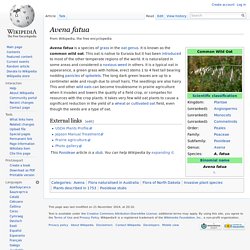
It is known as the common wild oat. This oat is native to Eurasia but it has been introduced to most of the other temperate regions of the world. It is naturalized in some areas and considered a noxious weed in others. Weed Gallery: Wild oat. Click on images to enlarge Wild oat is an erect, cool season annual grass with open-branched, nodding flower clusters.
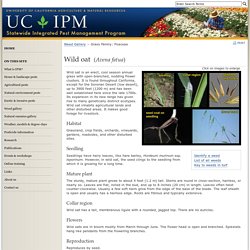
It is found throughout California, except for the Sonoran Desert (low desert), up to 3900 feet (1200 m) and has been well established here since the late 1700s. Its expansion in its new range has given rise to many genetically distinct ecotypes. Preparedness Advice Blog. Learn about the plants in your area.

I live in Northern California and every spring you see acres of yellow flowers. Most people ignore them, but a few know that you are looking at wild mustard. Raphanus raphanistrum. Raphanus raphanistrum, wild radish or jointed charlock, is a flowering plant in the family Brassicaceae.
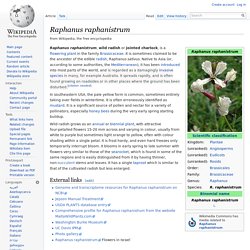
It is sometimes claimed to be the ancestor of the edible radish, Raphanus sativus. Native to Asia (or, according to some authorities, the Mediterranean), it has been introduced into most parts of the world, and is regarded as a damagingly invasive species in many, for example Australia. It spreads rapidly, and is often found growing on roadsides or in other places where the ground has been disturbed. Rumex crispus. Rumex crispus (curly dock, curled dock or yellow dock) is a perennial flowering plant in the family Polygonaceae, native to Europe and Western Asia.[1] Description[edit] The plant produces an inflorescence or flower stalk that grows to about 1 m high.
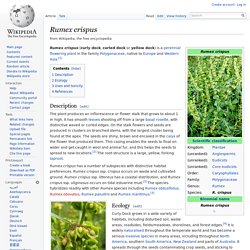
It has smooth leaves shooting off from a large basal rosette, with distinctive waved or curled edges. Sambucus. The genus occurs in temperate to subtropical regions of the world.
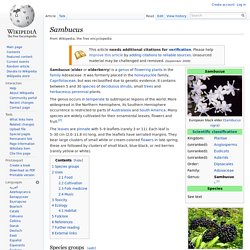
More widespread in the Northern Hemisphere, its Southern Hemisphere occurrence is restricted to parts of Australasia and South America. Many species are widely cultivated for their ornamental leaves, flowers and fruit.[2] The leaves are pinnate with 5–9 leaflets (rarely 3 or 11). Each leaf is 5–30 cm (2.0–11.8 in) long, and the leaflets have serrated margins.
Mugwort. 19th century illustration of Artemisia vulgaris Mugworts are used medicinally, especially in Chinese, Japanese, and Korean traditional medicine.
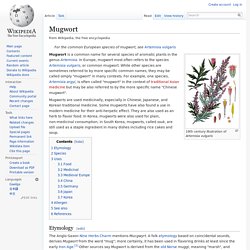
Some mugworts have also found a use in modern medicine for their anti-herpetic effect. They are also used as an herb to flavor food. In Korea, mugworts were also used for plain, non-medicinal consumption; in South Korea, mugworts, called ssuk, are still used as a staple ingredient in many dishes including rice cakes and soup. Juglans californica. Juglans californica, the California black walnut, also called the California walnut, or the Southern California black walnut, is a large shrub or small tree (up to 30 feet tall) of the Juglandaceae (walnut) family endemic to California.

Distribution[edit] J. californica is generally found in the southern California Coast Ranges, Transverse Ranges, and Peninsular Ranges, and the Central Valley. It grows as part of mixed woodlands, and also on slopes and in valleys wherever conditions are favorable. It is threatened by development and overgrazing. Juglans nigra. While its primary native region is the Midwest and east-central United States, the black walnut was introduced into Europe in 1629. It is cultivated there and in North America as a forest tree for its high-quality wood. Black walnut is more resistant to frost than the English or Persian walnut, but thrives best in the warmer regions of fertile, lowland soils with high water tables.
Black walnut is primarily a pioneer species similar to red and silver maple and black cherry. It will grow in closed forests, but needs full sun for optimal growth and nut production. Corylus cornuta. Corylus cornuta (Beaked Hazel) is a deciduous shrubby hazel found in most of North America, from southern Canada south to Georgia and California. It grows in dry woodlands and forest edges and can reach 4–8 metres (13–26 ft) tall with stems 10–25 centimetres (3.9–9.8 in) thick with smooth gray bark. The leaves are rounded oval, coarsely double-toothed, 5–11 centimetres (2.0–4.3 in) long and 3–8 centimetres (1.2–3.1 in) broad, with hairy undersides. The flowers are catkins that form in the fall and pollinate in the following spring.
Rubus parviflorus. Rubus parviflorus, commonly called thimbleberry,[1] is a species of Rubus, native to western and northern North America, and the Great Lakes region.[2] Distribution[edit] The plant is found from Alaska east to British Columbia, Ontario and Michigan; and south to California, Baja California, and New Mexico,[2] and further south into Northwestern Mexico.
California wild grape. Vitis californica. Vitis californica, the California wild grape, is a wild grape species native to most of California and southwestern Oregon.[1] The California wild grape grows along streams and rivers and thrives in damp areas; however, like most other native California plants it can withstand periods of dry conditions Description[edit] California Wild Grape - Sonoma County Master Gardeners. By Sonoma County Master Gardener Anne Brewer Fall has settled in, and brilliant colors abound to prove it! Deciduous trees are showing off glorious hues of yellow, orange, red and purple. One outstanding performer that often fails to get attention is Vitis californica, our native California wild grape, and its relatives. Plantago. Manzanita. Edible seaweed. Apple. Fragaria californica, Wood Strawberry. Claytonia perfoliata. Rosa californica. Fiddlehead fern. Typha. Huckleberry. Taraxacum. Urtica dioica. Umbellularia.
Malus. Salvia officinalis. Blackberry. Artemisia californica. Acorn. Tropaeolum. Lavandula. File:Oxalis-pes-caprae0021c.jpg. Oxalis. Rosemary. Cherry plum. Loquat. Fennel. A Beginner's Guide to Hunting Morel Mushrooms. Mallows - A nutritious edible weed. FeralKevin » Blog Archive » Acorns leached whole. FeralKevin » Blog Archive » Edible Pollen from Cedar Pine Part 2. FeralKevin » Blog Archive » Miner’s Lettuce and Chickweed — wild winter greens. FeralKevin » Blog Archive » How to Eat Bay Nuts (Umbellularia californica) FeralKevin » Blog Archive » Thistle Stems! How to rustle up a feast for free.